International Sustainability Institute’s Alley Network Project
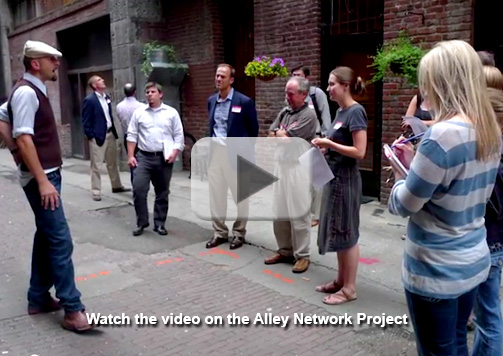
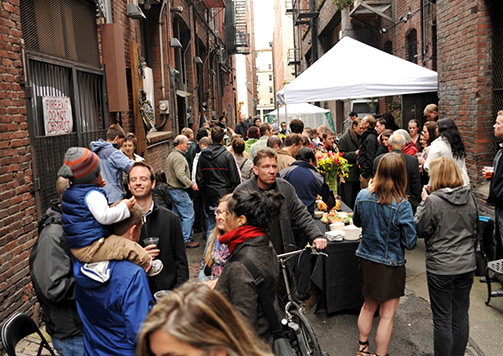 Changing Alley Culture: Events Create Healthy Behavior
Changing Alley Culture: Events Create Healthy BehaviorAn Alley Art event, featuring temporary and permanent art installations in Nord Alley. Photo Courtesy Mira Poling 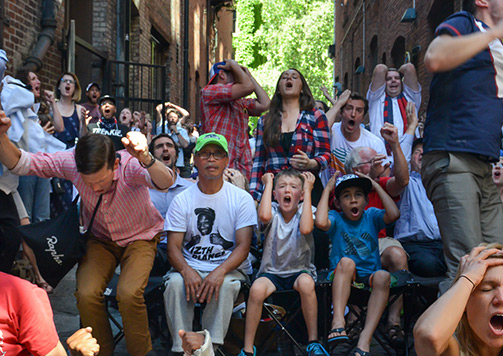 Making Alleys Fun, Part II – Letting the World Cup Break Your Heart
Making Alleys Fun, Part II – Letting the World Cup Break Your HeartWorld Cup 2014: One month of lunchtime viewing of the World Cup in Nord Alley. Photo courtesy Jeff Matarrese  Changing Alley Culture, Part III: Redefining How People Think About Using Alleys
Changing Alley Culture, Part III: Redefining How People Think About Using AlleysAlleypalooza featured concurrent events of art, music, and dance in various alleys. Maiah Manser featured. Photo courtesy Mitch Reinitz 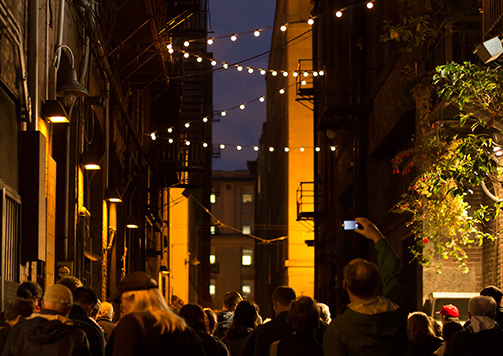 Helping Community See Anew: Community Building & Education
Helping Community See Anew: Community Building & EducationA Pioneer Square alley NIGHTSEEING™ event led by Leni Schwendinger. Photo courtesy Mitch Reinitz 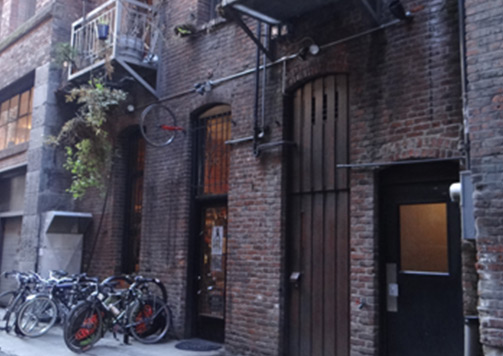 Alley Business Drives More Healthy Activity
Alley Business Drives More Healthy ActivityBack Alley Bike Repair: First alley shop to locate in a Pioneer Square alley. Photo courtesy International Sustainability Institute 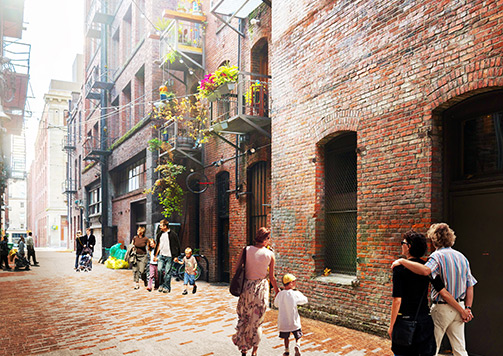 Making the Alleys More Inviting: Scheduled Physical Improvements
Making the Alleys More Inviting: Scheduled Physical ImprovementsSurface treatment designed by SvR Design Company and Olson Kundig Architects. Installation scheduled for 2016. Image courtesy SvR Design Company Great Alleys Create Great Communities in Historic SeattleThe Alley Network Project harnesses the energy and ideas of neighbors, businesses, colleagues, and community groups to transform Seattle's Pioneer Square alleys into one of its unrivaled assets. Alleys offer the opportunity for the historic district to boost healthy activity on its streets, feed its vibrant arts culture, draw people to local businesses, and even improve its basic infrastructure. Seven years ago, Pioneer Square businesses were stung by the recession. Retailers fled the neighborhood. Office workers left the area after work. The neighborhood felt empty, and the alleys reflected the pain. Drugs, prostitution, and garbage made them off-limits to most. Residents of one alley even kept a log of the calls they made to the police about illegal activity in their alley. Initiative and ImpactDuring the depths of the recession, the International Sustainability Institute, ISI, moved into the neighborhood. It was working on a collaborative study of downtown Seattle’s public spaces with the Copenhagen-based Gehl Architects, and the study, surprisingly, identified Pioneer Square alleys – with their nineteenth-century brick buildings lining a human-scale right-of-way – as having the potential to be transformed into some of the city’s great pedestrian spaces. The biggest hurdle was that no one had yet imagined the alleys as anything but a place for garbage and crime. ISI set out to redefine the space. Its method: fill the alleys with people. The first alley party on a rainy October in 2008 drew a small crowd of neighbors, office workers and passersby. The next party drew still more. Soon, residents along other alleys wanted to have their own events. Panels to hold revolving art exhibits went up, a glass-blowing shop on the alley created a sculpture, and increased healthy activity in the spaces led residents to begin naming their alleys and dreaming up ways to improve the spaces even more. Buildings tore the plywood off their back windows and residents put out hanging flower baskets. People increasingly turn the corner to walk down these passageways and discover history, art, and small shops. “I use the alley all the time. I water my plants in the wood planter boxes. I’ve gotten to know my neighbors. People now come by and say, ‘Hi Mary. Things are looking great!’” –Mary Peabody, Resident The City of Seattle designated Nord Alley as a Festival Street, allowing ISI to close the alley to cars on select days. ISI teamed up with the local business improvement association, the Alliance for Pioneer Square, and the increasingly popular alley events drew people to the struggling neighborhood. In tandem with a monthly art walk, alley events became a destination unto themselves. Since that rainy October party, Seattle residents have attended showings of the World Cup; the Tour de France; jazz, cello, and dance performances; cat adoptions; poetry slams, and photo slams. More than 6,000 people have attended a Pioneer Square Alley event. The alley events helped create a buzz around Pioneer Square during difficult economic times. New retail shops, housing, and offices now are moving into the neighborhood. The alleys are entering a new phase as new businesses take advantage of them as great places to be. "Now you have things you can visually explore while walking through the alley, rather than just trying to get through the alley," says Laguna Pottery owner Michael Lindsey. In 2011, Back Alley Bike Repair started serving neighborhood cyclists from a 700 square foot space that fronts the Nord Alley. A restaurant has built a deck out onto the alley for al fresco diners. Other shops and businesses are reconfiguring themselves to take advantage of the alley’s growing allure. Next StepsSo what comes next? Now that people are using the alleys, they want them to be more accessible. With support from the City, ISI sponsored a community-driven alley design process and hired engineers and architects to create an alley design that speaks to the area’s history, makes alleys accessible to everyone, and creates an easy-to-maintain surface. A lighting plan gives property owners aesthetically pleasing, energy efficient LEDs. Two alleys will be lit by the end of 2015, and at least one alley will receive a new surface in 2016. The new paving comes with a big economic benefit to the neighborhood. Outdated utilities fail to provide the neighborhood’s new businesses with enough electrical and fiber optic service. The new surface design removes a major hurdle to updating the utilities by providing a cost-effective template that meets both the standards of the Historic Board and the local department of transportation. Without community engagement and city collaboration, none of this would have been possible. The project unites residents, businesses, and property owners to expand Pioneer Square’s pedestrian-friendly streetscape to include its alleys. It works with city entities and leverages funds from government, private foundations, and local businesses, and draws together a wide array of people-public space experts, community organizers, marketing professionals and students. Together, they have problem-solved to reinvent the alleys. In time, these spaces will create a fine-grain walking grid for Pioneer Square pedestrians and a home for small, innovative, and unique shops. In turn, the community – and the sense of community – continues to grow. For more information on how you can bring this innovative model to your community, contact Liz Stenning at liz@pioneersquare.org or at 206-667-0687. Watch the video on the Alley Network ProjectClick here to view the press release |


